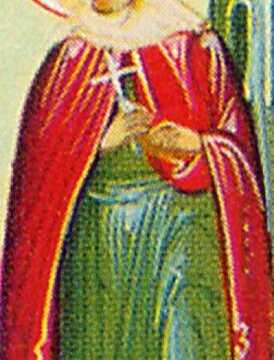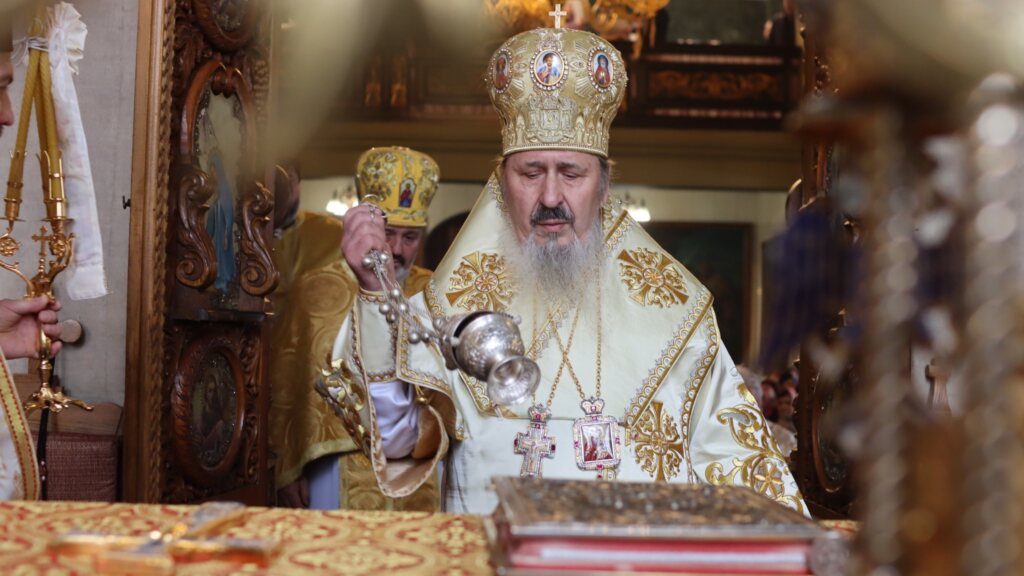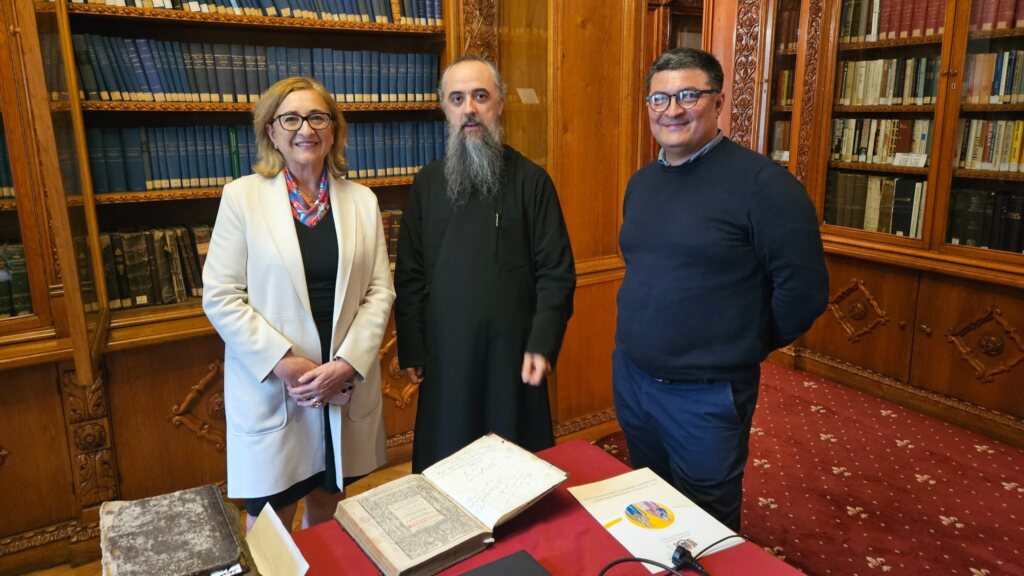1. This chosen person by God was born in Iviria (today’s Georgia) about 1650, to righteous parents, John and Maria, and baptised Andrew. Grown up in the spirit of the Orthodox tradition, young Andrew received from God the gifts of church painting and sculpture.
When the Turks invaded his native place, he was caught, made slave and taken to Constantinople, where he suffered the bitterness and humiliation of the life lived among foreigners alien to his nation and to his Christian faith. After a while he was redeemed by Christians and then he served God for many years as lay person at the Ecumenical Patriarchate, improving his artistic skilfulness and the knowledge of Greek, Turkish and Arabian.
About 1690, following the advice of the Patriarch of Jerusalem, Dositheus Notarius, he came to Wallachia, where the righteous ruler prince Constantin Brâncoveanu asked him to help with the printing of church books. He took up the monastic garment, received the name of Anthimus and he was ordained hieromonk at Snagov Monastery, near Bucharest.
In the summer of 1691, the former bishop of Huşi, Metrophanis, entrusted him the printing press of the Metropolitanate of Wallachia.
Having become igumen in the meantime and understanding the value of people’s education, in the summer of 1694, he set up a famous printing school at Snagov Monastery, always endeavouring to improve “printing work and to correct the Romanian words”, and publishing true treasures of books, like: Antologhion; The Four Gospels; Gifts Flower; Book or Light; Oktoichos; Chapters of Commandment; Church Teaching; Orthodox Confession of Faith; the first Greek-Arabian priest’s service book; Greek-Slavonic-Romanian Book of Hours.
On 16 March 1705, he was elected bishop of Râmnic, proving there also special qualities of administrator and of educated person, printing 9 books in less than three years, the most important of them being the Tomos of Joy, with almost 800 pages, including five polemic works against the Westerners who were trying to break up Orthodoxy in the Romanian Principalities and especially in Transylvania.
He repaired, painted and consecrated many churches as well as Strehaia, Surpatele, Cozia and Govora Monasteries. Very remarkable is the fact that bishop Anthimus began the series of some printings designed to make the Romanian language victorious in our Church. Thus, in 1706, he printed the Molitvelnic (Euchologion), the first Romanian edition in Muntenia.
On 22 February 1708, on the Sunday of Orthodoxy, he was enthroned metropolitan of Wallachia as a result of the will of metropolitan Theodosius, who had served the faithful of Wallachia for 40 years.
As soon as he was enthroned, Anthimus moved the printing press from Râmnic to Târgovişte, where he printed other 18 books, out of which 11 in Romanian. In 1713, he printed the Hieratikon in Romanian, confirming the victory of the Romanian language within the Church liturgical texts.
The most important work by metropolitan Anthimus is Didahiile (Collection of sermons). The book consists of 28 sermons delivered throughout his pastoral service, on the occasion of the Great (Royal) Feasts as well as various feasts of the Mother of God and of the Saints, including seven occasional speeches.
Metropolitan Anthimus unfolded a rich printing activity (63 books, 39 made by his own hand, 21 in Romanian language).
He did not print books to have his name famous for eternity, but chose to print the books most useful for priests and faithful, easily understood by all people, in the language of the people, the language which he enriched and adorned, having become founder of the Romanian literary and liturgical language.
Begun in the spring of 1713, All Saints Monastery, built in Bucharest by Metropolitan Anthimus according to his own plans, is really showing the spiritual seal of its founder.
“This holy church which I built for the glory of God and honour of All Saints, the result of my many works, is dedicated, with great devotion, to great God” – metropolitan Anthimus wrote in the Settlement of the Monastery, the will that he bequeathed to the community of this holy place of worship.
He wrote all these asking them to fulfil their vocation as much as possible, according to the commandments of the Gospel, for the benefit and salvation of the faithful, for helping the needy and the comfort of the distressed. No other personality of the time helped the poor and forgotten with so much determination and courage, love and good understanding.
Good patriot and fighter against the Turkish oppression which was already predicting the installation of the Phanariot’s regime, in March 1716, metropolitan Anthimus was arrested, suffered humiliation and torture in the princely prisons until autumn, when he was unjustly defrocked and sentenced to life imprisonment at Saint Catherine Monastery, in Mount Sinai.
But the Turkish soldiers killed him on their way to Sinai and threw his body in the waters of Tungia River, near Adrianople.
Saint Anthimus illuminated the spiritual life of his time through his remarkable deeds and gifts, through his humbleness, love for Church and fellow human beings, through his urge to repentance.
Only in 1966, the Ecumenical Patriarchate annulled the defrocking unjustly issued against Saint Anthimus and, on 21 June 1992, the Holy Synod of the Romanian Orthodox Church decided to include metropolitan Anthimus of Iviria in the calendar, as Saint Hierarch and Martyr, celebrated on 27 September.
Through his holy prayers, Lord Jesus Christ, our God, have mercy on us. Amen.
Troparion, tone 3:
Saint Hierarch and Father Anthimus, you were rightly appointed a shepherd and teacher of your flock and with divine wisdom you have poured out the rivers of your holy words. You did offer your life for your flock and have acquired the crown of martyrdom from Christ our God, Whom you pray, oh, Holy Hieromartyr Anthimus, to grant peace and great mercy to those who celebrate your holy remembrance.
2. Saint Callistratus was a native of Carthage. An ancestor of Saint Callistratus, Neochorus, has served under the emperor Tiberius in Palestine, under the command of Pontius Pilate, the procurator of Judea, and was a witness to the suffering on the Cross of our Lord Jesus Christ, His voluntary death and glorious Resurrection.
The saint’s father was a Christian, and he raised his son in faith and piety. Also like his father, Saint Callistratus became a soldier and excelled among his pagan military comrades by his good conduct and gentle disposition.
At night when everyone slept, he usually stayed up at prayer. Once, a soldier sleeping nearby heard Saint Callistratus invoking the Name of the Lord Jesus Christ, and he reported this to the military commander, who in turn summoned Callistratus, interrogated him and wanted to make him offer sacrifice to idols.
The saint resolutely refused to do this, so the military commander ordered that the saint be beaten. Then, covered with wounds, the saint was dragged over sharp stones. The beating and the torments did not sway the firm will and brave endurance of the sufferer.
The saint was sewn up in a leather sack and drowned in the sea. By God’s mercy, however, the sack struck a sharp rock and was torn open. Saint Callistratus came to dry land unharmed, carried by dolphins.
Viewing such a miracle, forty-nine soldiers came to believe in Christ. Then the military commander threw Saint Callistratus and the believing soldiers into prison. Before this, all of them were subjected to innumerable floggings.
In jail Saint Callistatus continued to preach the Word of God to the soldiers and he bolstered their spirits for martyrdom. Summoned again before the military commander, the sufferers firmly confessed their faith in Christ, after which they were bound hand and foot and thrown into a dam.
But there their bonds broke, and with bright faces the holy martyrs stood in the water, rejoicing in their Baptism, which coincided with the act of martyrdom.
Beautiful bright crowns appeared over their heads, and all heard a voice: “Be brave, Callistratus, with your company, and come rest in the eternal habitations.” At the same time, the earth shuddered and an idol standing nearby fell down and smashed. Seeing this, another 135 soldiers also believed in the Lord Jesus Christ.
The military commander, fearing a mutiny in the army, did not put them on trial, but again imprisoned Saint Callistratus with the others, where they fervently prayed and gave thanks to the Creator for giving them power to endure such sufferings.
At night the martyrs were cut to pieces with swords by order of the military commander. Their holy relics were buried by the 135 soldiers who remained alive. Later, a church was built on the spot of their sufferings, as Saint Callistatus had foretold.
3. The Holy Martyr Epicharis lived in Rome during the reign of Diocletian (284-305). For her steadfast confession of Christ as Savior they subjected her to tortures: they suspended her and tore at her body with iron hooks, and then they beat at her with tin threshing rakes.
The holy martyr prayed, and an angel of God struck down the torturers. Then Saint Epicharis was beheaded.
Tr by oca.org









